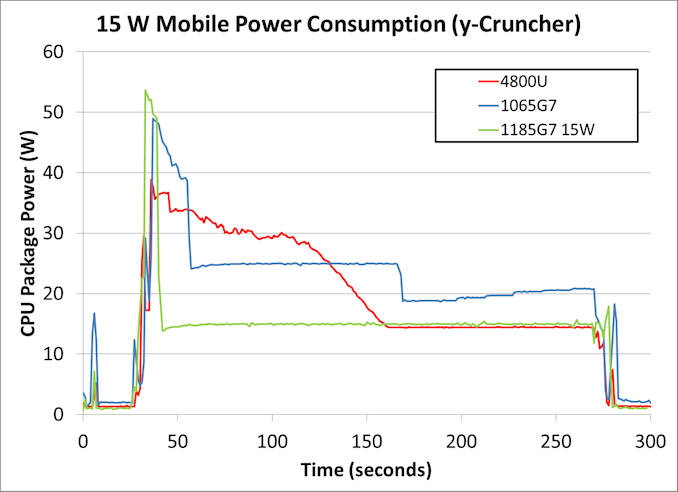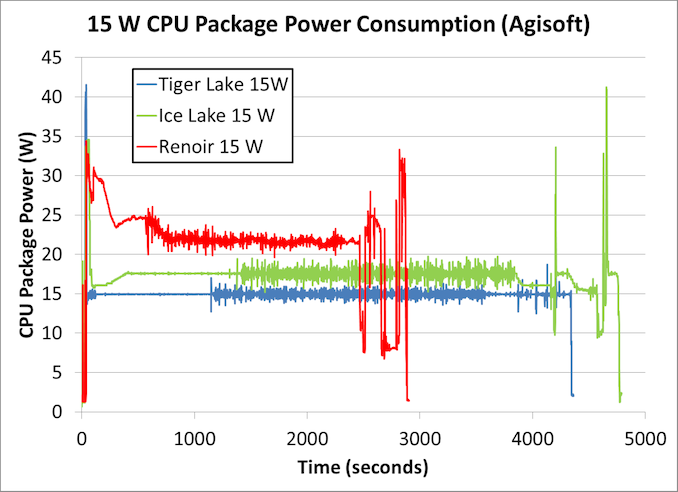Intel’s Tiger Lake 11th Gen Core i7-1185G7 Review and Deep Dive: Baskin’ for the Exotic
by Dr. Ian Cutress & Andrei Frumusanu on September 17, 2020 9:35 AM EST- Posted in
- CPUs
- Intel
- 10nm
- Tiger Lake
- Xe-LP
- Willow Cove
- SuperFin
- 11th Gen
- i7-1185G7
- Tiger King
Comparing 15 W TGL to 15 W ICL to 15 W Renoir
Despite the hullaballoo with the 28 W numbers on Tiger Lake, we suspect that most OEMs will still be positioning the hardware inside chassis built for the 15 W ultraportable market. This is where most of Intel’s OEMs have had success over the last decade, as the lower cooling requirements allow for a more user-friendly design. At 28 W, there is more of a cross-over into laptops that have discrete graphics options, and the main company that has succeeded in offering 28 W laptops without discrete graphics has been Apple - most Intel partners, if they want discrete graphics, end up looking at the 45 W processors with more cores.
So in that respect, our main battle should occur between the products built for 15 W. To that end we have been able to put the three together that will command this holiday season’s offerings: Ice Lake, Tiger Lake, and AMD’s Renoir.
- For our Ice Lake system, we have the Microsoft Surface Laptop 3. This has the top-of-the-line quad-core Core i7-1065G7, along with 16 GB of LPDDR4X-3733. Base 1.3 GHz, Turbo 3.9 GHz. Because this is an OEM design, Microsoft have determined the PL1 and PL2 values, and so they might be different from a ‘base’ design, however this is data from a real system.
- The Tiger Lake system is our Reference Design from Intel, running the quad-core Core i7-1185G7 at 15 W TDP mode. It has 16 GB of LPDDR4X-4266. Base 1.8 GHz, Turbo 4.8 GHz.
- Our AMD Renoir system is one of the most premium examples of AMD’s Ryzen Mobile in a 15W form factor, the Lenovo Yoga Slim 7 with the eight-core Ryzen 7 4800U processor. Even when set to the highest performance mode, the system still operates with a 15 W sustained power draw. It comes equipped with 16 GB of LPDDR4X-4266. Base 1.8 GHz, Turbo 4.2 GHz.
Compute Workload
For our 15 W comparisons, we can look again at the same benchmarks as the previous page. First up is y-Cruncher, an AVX2/AVX512 compute workload that tasks the CPU and the memory by calculating 2.5 billion digits of Pi, and requires ~11 GB of DRAM.
As we saw on the previous page, our Tiger Lake system in green at 15 W turbos up to ~53 watts before very quickly coming down to 15 W for the rest of the test.
The Microsoft Surface Laptop 3, by virtue of an OEM system, has different behavior - it turbos for longer, settles into a short turbo limit of 25 W, and then after about two minutes comes down to 20 W. The system then appears to opportunistically up the power draw until the end of the test, likely due to detecting extra thermal headroom.
The AMD Renoir processor does not turbo as high, peaking at only 38.9 W. Over the course of the next 100 seconds or slow, we see a small ramp down to just under 30 watts, before a more consistent decline over 30 seconds to 15 W, before staying at 15 W for the full test. The Renoir here has eight cores rather that four, but is running AVX2 rather than AVX-512 code.
The results are as follows:
- Ice Lake: 233 seconds, for 6072 joules, averaging 26.1 W
- Tiger Lake: 241 seconds for 4082 joules, averaging 17.0 W
- Renoir: 234 seconds for 5386 joules, averaging 23.0 W
All three systems perform the test in roughly the same amount of time, however the Tiger Lake system is very much ahead for efficiency. Tiger Lake effectively shaves off a third of the power from the previous generation Ice Lake system. We weren’t expecting this much of a jump from Ice Lake to Tiger Lake, but it would appear that Intel has done some work on the AVX-512 unit, and is putting that new high-performance transistor to use.
Professional ISV Workload
Moving onto the Agisoft test - as mentioned on the previous page, this is a 2D image to 3D modeling workflow where the algorithm comes in four stages, some of which prefer full multi-thread throughput, while others are more frequency and memory sensitive.
First, the Renoir finishes in almost half the time, mostly due to the fact that it has double the number of cores - there is no AVX-512 codepath in this test, and so all the processors rely on a mix of SSE, AVX, and perhaps some AVX2. That aside, the turbo behavior of Renoir is very interesting - we get almost 10 minutes of higher-than-base performance before the algorithm sets into a routine, hovering around 22 W. Because this test doesn’t attack the vector units as hard as the previous test, it may be a case that the Renoir system can manage the power distribution a bit better between the eight cores, allowing for the higher turbo.
Between the Ice Lake and the Tiger Lake, from the graph it would appear to be a double win for Tiger Lake, finishing in a shorter time but also consuming less power. The results are:
- 15 W Renoir: 2842 seconds for 62660 joules
- 15 W Ice Lake: 4733 seconds for 82344 joules
- 15 W Tiger Lake: 4311 seconds for 64854 joules
In this case, it’s a win for Renoir - a lot shorter time, and better power to boot, derived from the eight cores built on TSMC 7nm. Tiger Lake still represents a good jump over Ice Lake, offering 10% better performance at only 79% of the power, or a 13% increase in performance efficiency.












253 Comments
View All Comments
JayNor - Thursday, September 17, 2020 - link
vs Ice Lake the new TGL architecture doubles the bandwidth of the ring bus, adds pcie4, lpddr5, thunderbolt4 and a much superior GPU ... When will AMD catch up? They still need to add avx512, dlboost, integrate wifi6 and now they are further behind. Or do they just add two more cores and declare it even since they can win at cinebench?RSAUser - Thursday, September 17, 2020 - link
PCIe 4 will be next gen, and for current it doesn't really matter, pretty much no consumer SSD that can max it, and GPU is questionable.LPDDR5 should be 2022 with their next gen, which also includes PCIe5 by then.
AV512 doesn't matter, not something you run on a laptop, DLBoost is Intel trademarked, there are other ML libraries that AMD uses, and you're not really running ML training on a laptop CPU, you'd use the GPU.
The ring bus piece is an architecture difference, not sure why you're mentioning it? AMD's CCX design is better, Intel will be moving in that direction.
In regards to integrated WiFi 6/802.11ax, that's a separate module added to the mobo, AMD is not a communication tech company.
JayNor - Saturday, September 19, 2020 - link
Intel integrates the Wifi6 high speed digital components into the PCH chiplet in the same package with the cores on the laptop chips.They build a separate wifi6 chip that OEMs can use with the AMD chips.
JayNor - Saturday, September 19, 2020 - link
Intel's ring bus wins..."We can also see that, even in the 15W configuration, Tiger Lake's dual ring bus delivers slightly more throughput than the 4800U's Infinity Fabric, and has 30% more throughput at 28W with dynamic tuning."
https://www.tomshardware.com/features/intel-11th-g...
Rudde - Saturday, September 19, 2020 - link
You mean Intel caught up with AMD? Intel had a little over half the throughput of Renoir, when Renoir came out. Now Intel has caught up with AMD with Tiger Lake. AMD will likely pull ahead with Cezanne, continuing the back and forth.Spunjji - Saturday, September 19, 2020 - link
Wow, parity at 15W and a win at nearly twice the TDP. Such wins.Seriously, why do you need to pathologically overstate their achievements?
MetaCube - Friday, October 23, 2020 - link
"LPDDR5 should be 2022 with their next gen, which also includes PCIe5 by then." lmaoTheinsanegamerN - Thursday, September 17, 2020 - link
Maybe you dont care about having a better iGPU, but clearly its a selling point.huangcjz - Thursday, September 17, 2020 - link
I care about the integrated GPU. I only buy MacBooks, so AMD isn't a choice. I can't afford £2,400 for the 16" MacBook Pro with discrete graphics.playtech1 - Friday, September 18, 2020 - link
I've got some bad news for you... chances of Apple releasing a Tiger Lake MacBook looks very very slim